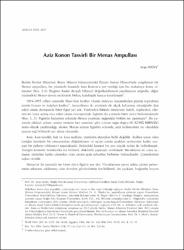| dc.contributor.author | Aydın, Ayşe | |
| dc.date.accessioned | 2020-11-20T17:51:46Z | |
| dc.date.available | 2020-11-20T17:51:46Z | |
| dc.date.issued | 2015 | |
| dc.identifier.issn | 1301-2746 | |
| dc.identifier.uri | https://app.trdizin.gov.tr//makale/TVRjeE9UZ3dNQT09 | |
| dc.identifier.uri | https://hdl.handle.net/20.500.12809/8807 | |
| dc.description.abstract | A Menas ampulla from Egypt was donated in 1894-1895 to the Museum of Byzantine Art at the Bode Museum of the Berlin State Museums. The terracotta ampulla is missing its neck and handles. On both faces are a figure orant in relief: one is Saint Menas flanked with camels and the other is Saint Konon with an amphora nearby. In comparison with ampullae with Menas depicted on both faces, those with Menas on one side and another saint on the other side are fewer in number. Among other saints depicted to- gether with Menas are Saint Thekla and Saint Konon of Isauria. The eastern Roman Emperor Zeno of Isauria (Tarasicodissa) established pilgrimage centers in the name of Saint Thekla in Isauria and Saint Menas at Alexandria-Mareotis and built churc - hes. Another pilgrimage center in Isauria is the Alahan Monastery encompassing three churches and other structures. It is usually agreed that the local cult here was of Saint Konon. It is also agreed that the original or secondary relics of Saint Konon and Saint Thekla were taken to the pilgrimage site of Saint Menas or a settlement nearby by the daughter Emperor Zeno. Except for one ampulla uncovered at Laodicea on the Lycus, a limited number of Menas ampullae or its fragments attested in Anatolia and Istanbul were actually purchased by the fa- ithful. It is generally agreed that the Menas ampullae were mass-produced with molds at Saint Menas or Abu Mena, from the end of the fifth century A.D. in parallel with the construction of the pilgrimage center to the mid-seventh century. The ampulla with Saint Konon acquired from Egypt by the Berlin State Museums should have been similarly produced so as well. Menas ampullae were decorated with depictions of Saint Konon when the secondary relics of Saint Konon, the second most important saint of Isauria, were brought to the Saint Menas (Abu Mena) pilgrimage center during the reign of Emperor Zeno. Menas ampullae depicting other saints in addition to Saint Konon should be considered important evidence reflecting the exchange of saints’ relics between regions and pilgrimage centers in the Early Christian/ Byzantine period. | en_US |
| dc.description.abstract | Berlin Devlet Müzeleri, Bode Müzesi bünyesindeki Bizans Sanatı Müzesi’nde sergilenen bir
Menas ampullası, bir yüzünde Isaurialı Aziz Konon’a yer verdiği için bu makaleye konu olmuştur
(Res. 1-3). Bugüne kadar detaylı bilimsel değerlendirmesi yapılmayan ampulla, diğer
yüzündeki Menas tasviri nedeniyle birkaç katalogda kısaca tanıtılmıştır | |
| dc.item-language.iso | tur | en_US |
| dc.item-rights | info:eu-repo/semantics/openAccess | en_US |
| dc.subject | Arkeoloji | en_US |
| dc.title | Aziz Konon Tasvirli Bir Menas ampullası | en_US |
| dc.item-title.alternative | A Menas ampulla with Saint Konon | en_US |
| dc.item-type | article | en_US |
| dc.contributor.department | MÜ, Edebiyat Fakültesi, Sanat Tarihi Bölümü | en_US |
| dc.contributor.institutionauthor | Aydın, Ayşe | |
| dc.identifier.volume | 0 | en_US |
| dc.identifier.issue | 18 | en_US |
| dc.identifier.startpage | 289 | en_US |
| dc.identifier.endpage | 302 | en_US |
| dc.relation.journal | Adalya | en_US |
| dc.relation.publicationcategory | Makale - Ulusal Hakemli Dergi - Kurum Öğretim Eleman | en_US |


















